外研版(2019)选择性必修 第二册Unit 5 A delicate world Developing ideas 课件(共53张,内嵌音视频)
文档属性
| 名称 | 外研版(2019)选择性必修 第二册Unit 5 A delicate world Developing ideas 课件(共53张,内嵌音视频) | 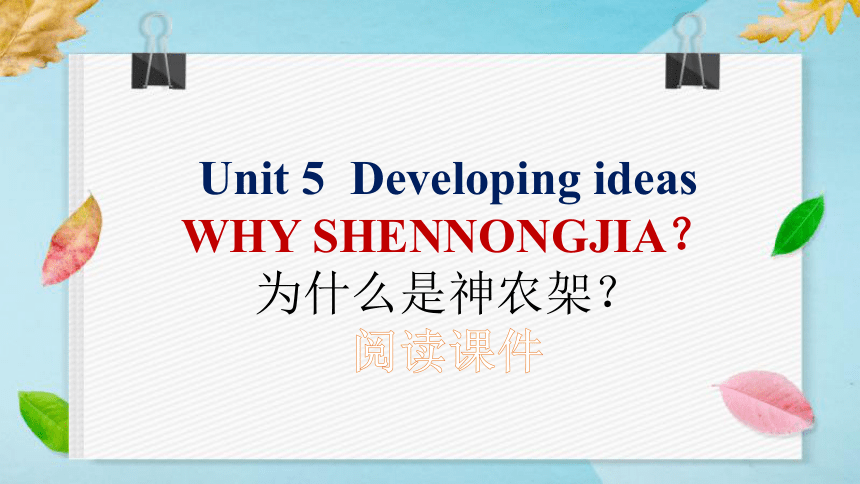 | |
| 格式 | pptx | ||
| 文件大小 | 38.6MB | ||
| 资源类型 | 教案 | ||
| 版本资源 | 外研版(2019) | ||
| 科目 | 英语 | ||
| 更新时间 | 2024-11-21 11:46:05 | ||
图片预览

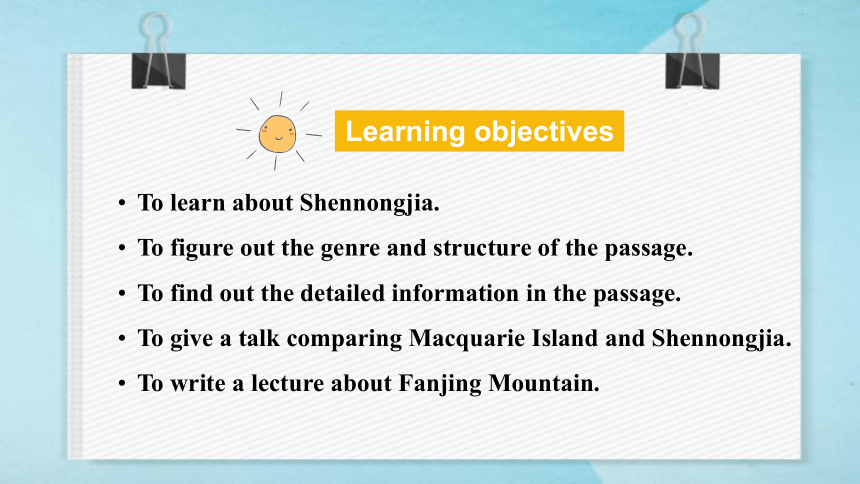

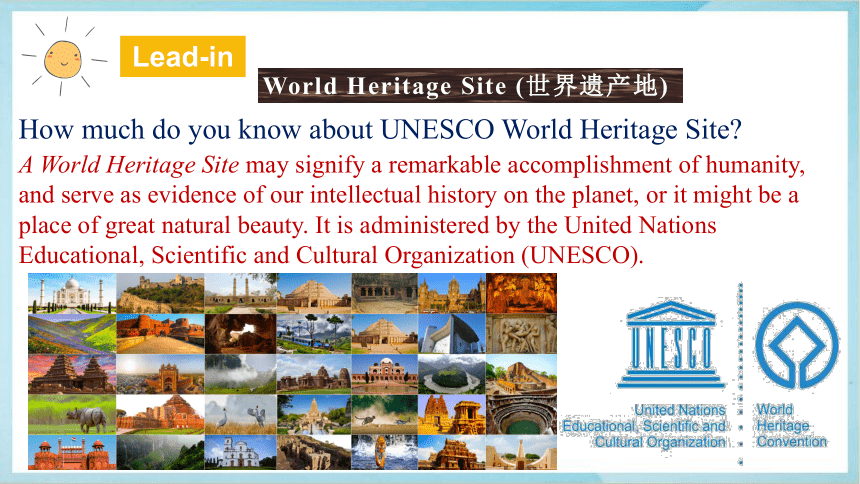

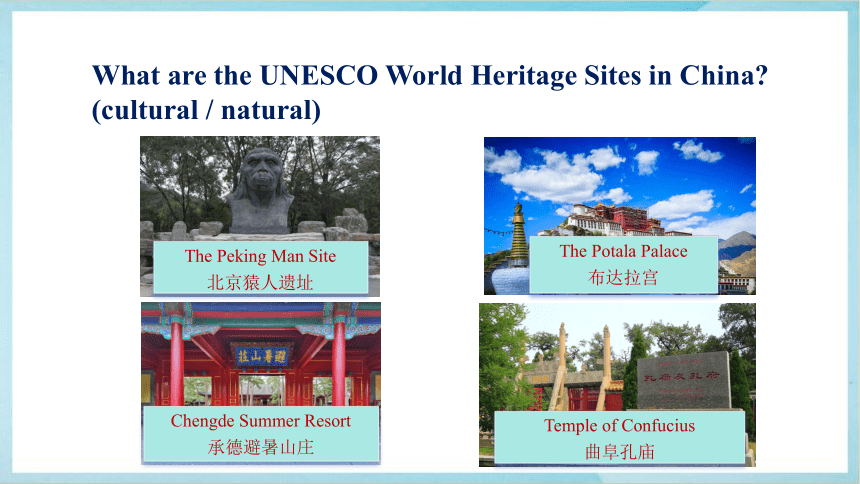
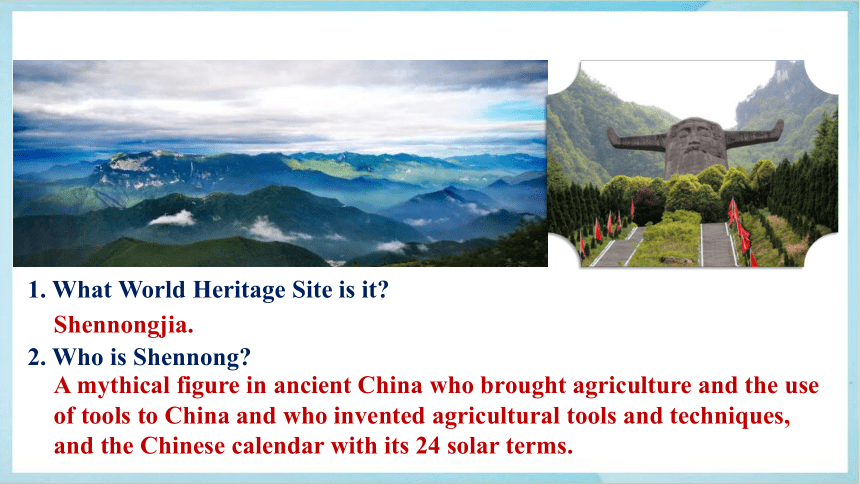
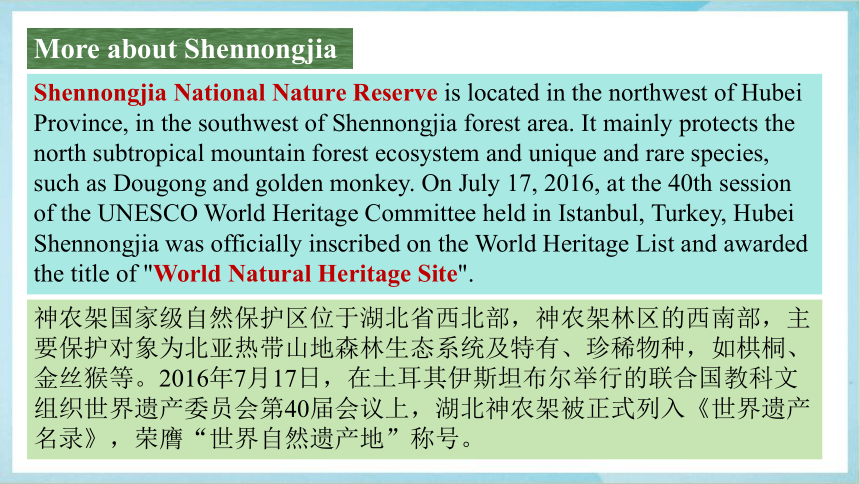
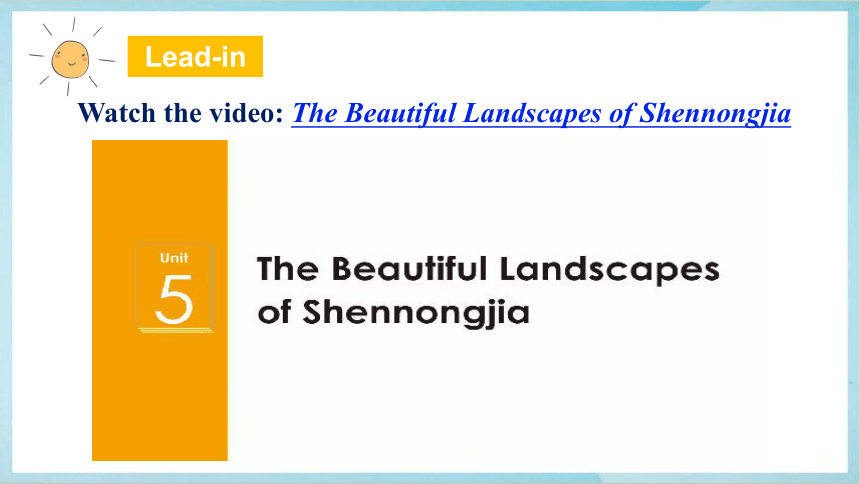
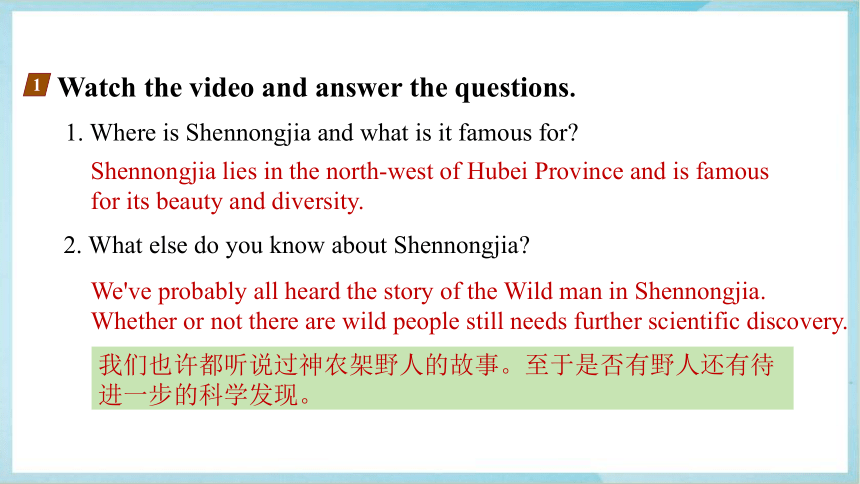
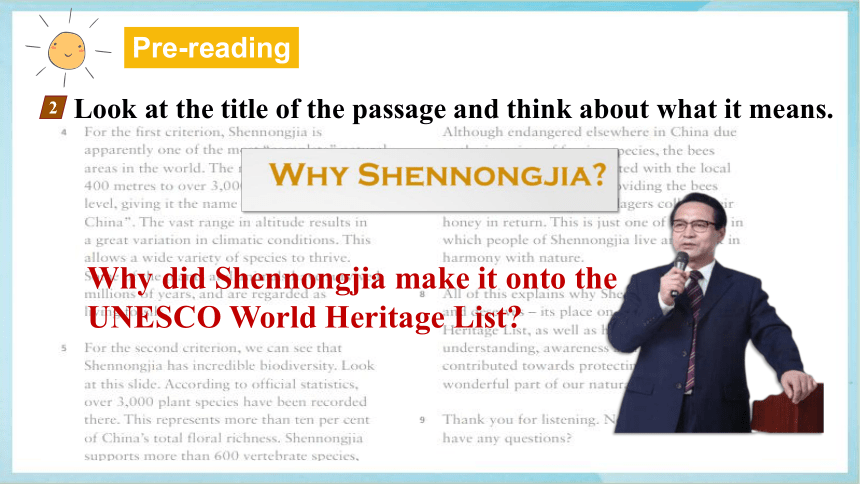
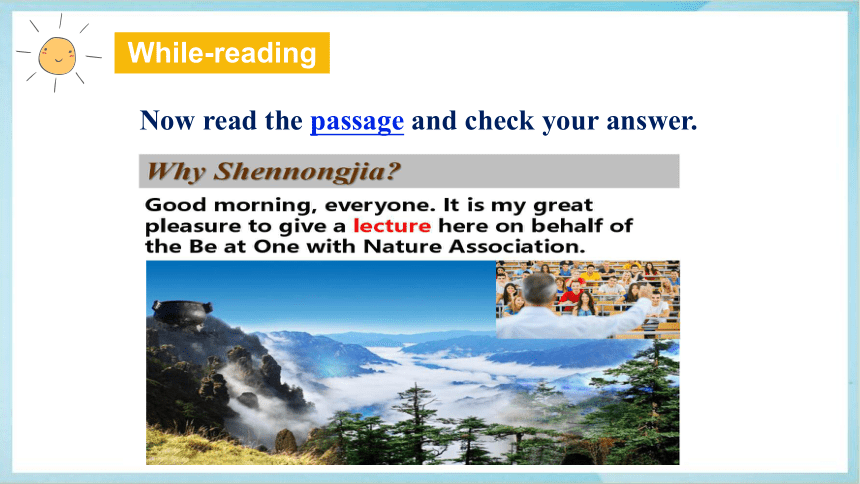
文档简介
(共53张PPT)
Unit 5 Developing ideas
WHY SHENNONGJIA?
为什么是神农架?
阅读课件
To learn about Shennongjia.
To figure out the genre and structure of the passage.
To find out the detailed information in the passage.
To give a talk comparing Macquarie Island and Shennongjia.
To write a lecture about Fanjing Mountain.
Learning objectives
Word and expressions
dissolve v. (使)溶解 54
nutrient n. 养分,营养物 54
comparison n. 比较 56
visual adj. 视觉的 56
session n. 一段时间 56
on behalf of 代表 56
herbal adj. 用香(药)草制成的 56
mysterious adj. 神秘的 56
status n. 地位;身份 56
criterion n. 标准,准则 56
prosper v. 兴旺,发达 56
rare adj. 稀有的,罕见的 56
biological adj. 生物的,与生物有关的 56
apparently adv. 据说;看来,似乎 57
vast adj. 巨大的;广大的 57
altitude n. 海拔(高度) 57
variation n. 差异;变化 57
thrive v. 茁壮成长 57
fossil n.化石 57
floral adj. 花的 57
vertebrate n. 脊椎动物 57
beehive n. 蜂房,蜂箱 57
endangered adj. 濒临灭绝的 57
elsewhere adv. 在别处 57
invasion n. 涌入 57
coexist v. 共存,共处 57
secure adj. 稳固的;安全的 57
greeting n. 问候,招呼 59
How much do you know about UNESCO World Heritage Site
A World Heritage Site may signify a remarkable accomplishment of humanity, and serve as evidence of our intellectual history on the planet, or it might be a place of great natural beauty. It is administered by the United Nations Educational, Scientific and Cultural Organization (UNESCO).
World Heritage Site (世界遗产地)
Lead-in
What are the UNESCO World Heritage Sites in China (cultural / natural)
the Terracotta Army
秦始皇兵马俑
the Great Wall
长城
the Imperial Palace
故宫
Mogao Caves
莫高窟
The Peking Man Site
北京猿人遗址
The Potala Palace
布达拉宫
Chengde Summer Resort
承德避暑山庄
Temple of Confucius
曲阜孔庙
What are the UNESCO World Heritage Sites in China (cultural / natural)
1. What World Heritage Site is it
Shennongjia.
2. Who is Shennong
A mythical figure in ancient China who brought agriculture and the use of tools to China and who invented agricultural tools and techniques, and the Chinese calendar with its 24 solar terms.
Shennongjia National Nature Reserve is located in the northwest of Hubei Province, in the southwest of Shennongjia forest area. It mainly protects the north subtropical mountain forest ecosystem and unique and rare species, such as Dougong and golden monkey. On July 17, 2016, at the 40th session of the UNESCO World Heritage Committee held in Istanbul, Turkey, Hubei Shennongjia was officially inscribed on the World Heritage List and awarded the title of "World Natural Heritage Site".
神农架国家级自然保护区位于湖北省西北部,神农架林区的西南部,主要保护对象为北亚热带山地森林生态系统及特有、珍稀物种,如栱桐、金丝猴等。2016年7月17日,在土耳其伊斯坦布尔举行的联合国教科文组织世界遗产委员会第40届会议上,湖北神农架被正式列入《世界遗产名录》,荣膺“世界自然遗产地”称号。
More about Shennongjia
Watch the video: The Beautiful Landscapes of Shennongjia
Lead-in
Watch the video and answer the questions.
1. Where is Shennongjia and what is it famous for
2. What else do you know about Shennongjia
Shennongjia lies in the north-west of Hubei Province and is famous for its beauty and diversity.
We've probably all heard the story of the Wild man in Shennongjia. Whether or not there are wild people still needs further scientific discovery.
我们也许都听说过神农架野人的故事。至于是否有野人还有待进一步的科学发现。
1
Look at the title of the passage and think about what it means.
Why did Shennongjia make it onto the UNESCO World Heritage List
2
Pre-reading
Now read the passage and check your answer.
While-reading
What is the genre of the passage
The genre of the passage is lecture.
Good morning, everyone. It is my great pleasure to
give a lecture here on behalf of the Be at One with Nature Association.
Thank you for listening. Now, does anyone have any questions
Read for genre
Learning to learn
The lecture is one of the oldest teaching methods, and is still widely used today. A typical lecture often starts with addressing the topic directly. Data, examples and comparisons are then used to
support the main ideas. Both verbal and visual information is used in order to maintain the audience’s interest. The end of a lecture is often followed by a short question-and-answer session.
演讲时常用说明方法:
列数据 (give data)、举例子 (examples)、作比较 (make comparisons).
列数据 (give data): 用具体的数据对事物的特征或事理加以说明,使说明更准确、更有说服力。
举例子 (examples): 通过具体的实例对事物的特征或事理加以说明,使说明更加生动形象、易于理解。
作比较 (make comparisons): 将两个事物放在一起进行比较,呈现事物的相同点和不同点。
Read for structure
Why Shennongjia
Opening
(Para 1-2)
Greeting (Para 1)
Introduction(Para 2 )
Reasons for selection
(Para 3-5)
Two criteria(Para 3)
Naturally- balanced environment (Para 4)
Biodiversity
(Para 5)
People live in harmony with nature (Para 6-7)
Scientists (Para 6)
Local people (Para 7)
Conclusion
(Para 8)
Q&A (Para 9)
understanding, awareness and hard work
Para. 1-2 Greeting + introduction
Para. 1: Good morning, everyone. It is my great pleasure to give a lecture here on behalf of the Be at One with Nature Association.
Para. 2: As we know, in 2016, Shennongjia made it onto the UNESCO World Heritage List. But there are so many important places not yet on this list. So you might ask: why Shennongjia Is it its forests that stretch on and on like great green seas Is it the legendary father of Chinese herbal medicine, Shennong, after whom the park is named Or is it the mysterious creature called “Yeren” (wild man) that has captured the imagination of the world
To get the audience's attention.
Why here the author use so many question sentences
Read for details
Para. 3 Criteria for selection
What are the criteria required by the UNESCO World Heritage List
Para. 3: UNESCO awarded Shennongjia this status because it meets
two criteria required by the list. It contains a naturally-balanced environment that allows the many and various species to live and prosper. It is also one of the rare locations in the world where scientists can observe in real time the ecological and biological processes that occur as the plants and animals develop and evolve.
Containing a naturally-balanced environment and being one of the rare locations in the world where scientists can observe in real time the ecological and biological processes.
Read for details
Para. 4 Criteria for selection-a naturally- balanced environment
What makes Shennongjia the most “complete” natural areas in the world
Shennongjia rises from about 400 metres to over 3,000 metres above sea level, which results in a great variation in climatic conditions, allowing a wide variety of species to thrive.
Para. 4: For the first criterion, Shennongjia is apparently one of the most “complete” natural areas in the world. The region rises from about 400 metres to over 3,000 metres above sea level, giving it the name the “Roof of Central China”. The vast range in altitude results in a great variation in climatic conditions. This allows a wide variety of species to thrive. Some of the plants and animals have survived millions of years, and are regarded as living fossils.
give data
Read for details
Para. 5 Criteria for selection-biodiversity
Para. 5: For the second criterion, we can see that Shennongjia has incredible biodiversity. Look at this slide. According to official statistics, over 3,000 plant species have been recorded there. This represents more than ten per cent of China’s total floral richness. Shennongjia supports more than 600 vertebrate species, including the Golden Snub-nosed Monkey and the Clouded Leopard. Additionally, around 4,300 insect species have been recorded.
①
②
③
④
①②④ give data
③give data+examples
Read for details
Para. 5 Criteria for selection-biodiversity
Read carefully and fill in the blanks.
incredible biodiversity
over 3,000 _____ species
more than ten per cent of China’s total _____________
more than ____ vertebrate species
the Golden Snub-nosed Monkey and _____________________
around 4,300 ______ species
plant
floral richness
600
the Clouded Leopard
insect
Read for details
Para. 6 Protective measures-scientists
How does the scientists protect the species
They brave heavy snow and freezing temperatures to look after the species.
Para. 6: It is a challenge to look after so many species. In winter, scientists brave heavy snow and freezing temperatures to supply food to the Golden Snub-nosed Monkey. Thanks to their efforts, the monkey’s population has doubled since the 1980s. Their number reached over 1,300 in 2015 and continues to grow.
examples
Read for details
Para. 7 Protective measures-local people
But the most impressive aspect of Shennongjia is the local people, who take things from nature without causing damage. I visited a local village which is known for its home-made honey. What is special about the honey is that it is produced by the earliest species of Chinese bee. Every spring, the villagers place beehives around their houses to attract these wild bees from the forest. Although endangered elsewhere in China due to the invasion of foreign species, the bees of Shennongjia have coexisted with the local people for centuries. By providing the bees with a secure home, the villagers collect their honey in return. This is just one of the ways in which people of Shennongjia live and work in harmony with nature.
make comparisons
Read for details
Read carefully and fill in the blanks.
The local people
Bees
providing them ________________
providing them ________________
People of Shennongjia live and work
________________ nature.
with honey
with a secure home
in harmony with
Para. 7 Protective measures-local people
Read for details
Para. 8 Conclusion
Para. 9 Q & A
All of this explains why Shennongjia earned – and deserves – its place on the UNESCO World Heritage List, as well as highlighting how understanding, awareness and hard work have contributed towards protecting a unique and wonderful part of our natural world.
Thank you for listening. Now, does anyone have any questions
Read for details
The region rises from about 400 metres to over 3,000 metres above sea level, ... _____
… over 3,000 plant species have been recorded there. This represents more than ten per cent of China’s total floral richness. _____
Shennongjia supports more than 600 vertebrate species, including the Golden Snub-nosed Monkey and the Clouded Leopard. _____
In winter, scientists brave heavy snow and freezing temperatures to support food to the Golden Snub-nosed Monkey. _____
Although endangered elsewhere in China due to the invasion of
foreign species, the bees of Shennongjia have coexisted with the
local people for centuries. _____
D
D
D
E
C
Read the sentences from the passage and decide if they serve to give data (D), examples(E) or make comparisons (C).
3
Post-reading
1. What roles do the questions in Paragraph 2 play
The questions in Paragraph 2 serve to introduce the topic and attract the audience.
Think and share
2. According to the passage, what has been done to protect the ecology of Shennongjia
To protect the ecology of Shennongjia, scientists make every effort to look after the species. In winter, scientists brave heavy snow and freezing temperatures to supply food to the Golden Snub-nosed Monkey. More importantly, the local peoole live in harmony with nature. They take things from nature without damaging it.
3. Which part of Shennongjia interests you most Why
What interests me most is that Shennongjia has so many species and has a long history.
It is said that Emperor Yan, Shennong taught the first people living here how to build houses, find herbs, and farm the land, so the area is called Shennongjia.
Think and share
Work in groups. Give a talk comparing Macquarie Island and Shennongjia.
1. Think about the similarities and differences between Macquarie Island and Shennongjia and make notes.
4
Macquarie Island Shennongjia
Similarities
Differences (M=Macquarie, S=Shennongjia)
Both have unique animals.
Both have wild and natural beauty.
Both are UNESCO World Heritage sites.
M is an island.
S is a mountaionous area.
M was in chaos due to the introduction of non-native species.
S has always been in natural harmony.
The native species existed for thousands of years.
Some of the plants and animals have survived over millions of years.
S has more varied species of plants and animals.
2. Decide what conclusions you can draw from comparing the two places and what you
would like to include in your talk.
3. Give your talk to the class.
Now think about how effectively you used the language you have learnt to talk about the similarities and differences.
Writing
Drafting a lecture
Read the passage and answer the questions.
If you haven’t already heard of Fanjing Mountain, you soon will! A “must” for anyone visiting Guizhou Province, Fanjing Mountain has now been added to the UNESCO World Heritage List, bringing the total number of UNESO sites in China to 53. The main reason for its inclusion is its biological diversity, with approximately 50 endangered plant and animal species found in its protected area. One of the first national nature reserves in China, Fanjing Mountain represents one of the country's greatest achievements in environmental protection. It is also renowned for its breathtaking scenery as a summer resort.
5
1. Where is Fanjing Mountain Why is it significant
2. Why was Fanjing Mountain selected for inclusion in the UNESCO World Heritage List
Fanjing Mountain is located in Guizhou Province. It is significant because it represents one of the country's great achievements in enviromental protection.
The main reason for its inclusion is its biological diversity, with approximately 50 endangered plant and animal species within its protected area.
Read the passage and answer the questions.
5
Opening 1. greating
2. introduction to the topic __________________________
________________________________
Reason for selection
Other information
Conclusion
Q&A
its biological diversity, with approximately 50 endangered plant and animal species
Have you ever heard of Fanjing Mountain Or have you ever visited it
Fanjing Mountain is of course also renowned for the breathtaking views from its summit...
And when night falls leaving this magnificent scenery in darkness, the Mushroom Stone,...
All explains why Fanjing Mountain earned its place on the UNESCO World Heritage List.
Thank you for your listening! Now, does anyone have any questions
Complete the outline to organise your lecture draft based on the information in Activity 5. Do online research if necessary.
6
Sample writing
The Wonders of Fanjing Mountain
Good afternoon, everyone! I'm very happy to be here to give a short lecture.
Have you ever heard of Fanjing Mountain Or have you ever visited it If you haven't, you soon will! Fanjing Mountain lies in Tongren, Guizhou Province with an elevation of about 2,570 metres. It is the highest peak of the Wuling Mountain range in south-west China. Fanjing Mountain was added to the UNESCO World Heritage List in 2018.
The Fanjingshan Nature Reserve was established in 1978 and represents one of the country's greatest achievements in environmental protection. The rich biodiversity of the Wuling Mountain range is the principal reason for Fanjing Mountain's inclusion in the UNESCO World Heritage prising the largest subtropical primeval beech forest, the region is home to 2,000 species of plants, such as the endangered Chinese dove tree.
Endangered animal species that can be found on Fanjing Mountain and its surrounding mountain range include the Chinese giant salamander, forest musk deer and grey snub-nosed monkey.
Fanjing Mountain is of course also renowned for the breathtaking views from its summit-or, more accurately "summits", as there are three of these! And when night falls leaving this magnificent scenery in darkness, the Mushroom Stone, one of the many strange rock formations, is illuminated so that visitors can still marvel at the wonders of Fanjing Mountain.
All explains why Fanjing Mountain earned its place on the UNESCO World Heritage List.
Thank you for your listening! Now, does anyone have any questions
Work in pairs. Make improvements to each other’s lecture drafts and share them with the class.
7
Presenting ideas
Clear Waters and Lush Mountains Are as Valuable as Gold and Silver.
Clear Waters and Lush Mountains Are as Valuable as Gold and Silver.
Xi Jinping
1
Read the quote and answer the questions.
金山银山不如绿水青山。
习近平
1. What is your understanding of “clear waters and lush mountains” and “gold and silver”
“Clear waters and lush mountains” refers to our natural environments and “Gold and Silver” refers to invaluable assets.
2. What message is conveyed by the quote
The quote conveys that natural environments are also invaluable assets and we should make every effort to protect them.
1
Read the quote and answer the questions.
How is your living environment
What was it like in the past
What have you done
1
Read the quote and answer the questions.
My understanding:
My example(s):
Conclusion:
Work in groups. Talk about your understanding of the quote. Find example(s) that can prove it and make notes.
2
Understand the quote better by finding when and in what background President Xi Jinping said it.
Get information from news in local newspaper.
Find out the changes of environment.
Exchange your information with partners.
Prepare a short speech. Consider the following:
1. the structure of your speech
2. useful words, expressions and structures
Give your speech to the class. Vote for the best speech.
3
4
Write a reflection after completing this unit. Consider the following:
1 What is your understanding of ecosystems and what should we do to protect them
2 What text types have you learnt about What are their features
3 What words, expressions and structures have you learnt
4 What improvement have you made in understanding different cultures
5 What improvement have you made in using learning strategies and exploring effective ways of learning
6 What improvement have you made in analyzing and solving problems
China will uphold the concept that clear waters and lush mountains are as valuable as gold and silver, strive to win the battles against air, water and soil pollution, encourage the development of green industries and renewable energy, and promote economical use and recycling of resources.
Let’s look at more quotes and information.
The world is a greener place than it was 20 years ago. Data from NASA Earth satellites shows that human activity in China and India dominate this greening of the planet, thanks to tree planting and agriculture.
China alone accounts for 25% of the global net increase in leaf area with only 6.6% of global vegetated area.
中国仅占全球植被面积的6.6%,但全球植被叶面积净增长的25%都来自中国。
Only by observing the laws of nature can mankind avoid costly blunders in its exploitation. Any harm we inflict on nature will eventually return to haunt us. This is a reality we have to face.
“人类只有遵循自然规律才能有效防止在开发利用自然上走弯路,人类对大自然的伤害最终会伤及人类自身,这是无法抗拒的规律。”
Write a lecture concerning the famous A World Heritage Site.
Homework
Unit 5 Developing ideas
WHY SHENNONGJIA?
为什么是神农架?
阅读课件
To learn about Shennongjia.
To figure out the genre and structure of the passage.
To find out the detailed information in the passage.
To give a talk comparing Macquarie Island and Shennongjia.
To write a lecture about Fanjing Mountain.
Learning objectives
Word and expressions
dissolve v. (使)溶解 54
nutrient n. 养分,营养物 54
comparison n. 比较 56
visual adj. 视觉的 56
session n. 一段时间 56
on behalf of 代表 56
herbal adj. 用香(药)草制成的 56
mysterious adj. 神秘的 56
status n. 地位;身份 56
criterion n. 标准,准则 56
prosper v. 兴旺,发达 56
rare adj. 稀有的,罕见的 56
biological adj. 生物的,与生物有关的 56
apparently adv. 据说;看来,似乎 57
vast adj. 巨大的;广大的 57
altitude n. 海拔(高度) 57
variation n. 差异;变化 57
thrive v. 茁壮成长 57
fossil n.化石 57
floral adj. 花的 57
vertebrate n. 脊椎动物 57
beehive n. 蜂房,蜂箱 57
endangered adj. 濒临灭绝的 57
elsewhere adv. 在别处 57
invasion n. 涌入 57
coexist v. 共存,共处 57
secure adj. 稳固的;安全的 57
greeting n. 问候,招呼 59
How much do you know about UNESCO World Heritage Site
A World Heritage Site may signify a remarkable accomplishment of humanity, and serve as evidence of our intellectual history on the planet, or it might be a place of great natural beauty. It is administered by the United Nations Educational, Scientific and Cultural Organization (UNESCO).
World Heritage Site (世界遗产地)
Lead-in
What are the UNESCO World Heritage Sites in China (cultural / natural)
the Terracotta Army
秦始皇兵马俑
the Great Wall
长城
the Imperial Palace
故宫
Mogao Caves
莫高窟
The Peking Man Site
北京猿人遗址
The Potala Palace
布达拉宫
Chengde Summer Resort
承德避暑山庄
Temple of Confucius
曲阜孔庙
What are the UNESCO World Heritage Sites in China (cultural / natural)
1. What World Heritage Site is it
Shennongjia.
2. Who is Shennong
A mythical figure in ancient China who brought agriculture and the use of tools to China and who invented agricultural tools and techniques, and the Chinese calendar with its 24 solar terms.
Shennongjia National Nature Reserve is located in the northwest of Hubei Province, in the southwest of Shennongjia forest area. It mainly protects the north subtropical mountain forest ecosystem and unique and rare species, such as Dougong and golden monkey. On July 17, 2016, at the 40th session of the UNESCO World Heritage Committee held in Istanbul, Turkey, Hubei Shennongjia was officially inscribed on the World Heritage List and awarded the title of "World Natural Heritage Site".
神农架国家级自然保护区位于湖北省西北部,神农架林区的西南部,主要保护对象为北亚热带山地森林生态系统及特有、珍稀物种,如栱桐、金丝猴等。2016年7月17日,在土耳其伊斯坦布尔举行的联合国教科文组织世界遗产委员会第40届会议上,湖北神农架被正式列入《世界遗产名录》,荣膺“世界自然遗产地”称号。
More about Shennongjia
Watch the video: The Beautiful Landscapes of Shennongjia
Lead-in
Watch the video and answer the questions.
1. Where is Shennongjia and what is it famous for
2. What else do you know about Shennongjia
Shennongjia lies in the north-west of Hubei Province and is famous for its beauty and diversity.
We've probably all heard the story of the Wild man in Shennongjia. Whether or not there are wild people still needs further scientific discovery.
我们也许都听说过神农架野人的故事。至于是否有野人还有待进一步的科学发现。
1
Look at the title of the passage and think about what it means.
Why did Shennongjia make it onto the UNESCO World Heritage List
2
Pre-reading
Now read the passage and check your answer.
While-reading
What is the genre of the passage
The genre of the passage is lecture.
Good morning, everyone. It is my great pleasure to
give a lecture here on behalf of the Be at One with Nature Association.
Thank you for listening. Now, does anyone have any questions
Read for genre
Learning to learn
The lecture is one of the oldest teaching methods, and is still widely used today. A typical lecture often starts with addressing the topic directly. Data, examples and comparisons are then used to
support the main ideas. Both verbal and visual information is used in order to maintain the audience’s interest. The end of a lecture is often followed by a short question-and-answer session.
演讲时常用说明方法:
列数据 (give data)、举例子 (examples)、作比较 (make comparisons).
列数据 (give data): 用具体的数据对事物的特征或事理加以说明,使说明更准确、更有说服力。
举例子 (examples): 通过具体的实例对事物的特征或事理加以说明,使说明更加生动形象、易于理解。
作比较 (make comparisons): 将两个事物放在一起进行比较,呈现事物的相同点和不同点。
Read for structure
Why Shennongjia
Opening
(Para 1-2)
Greeting (Para 1)
Introduction(Para 2 )
Reasons for selection
(Para 3-5)
Two criteria(Para 3)
Naturally- balanced environment (Para 4)
Biodiversity
(Para 5)
People live in harmony with nature (Para 6-7)
Scientists (Para 6)
Local people (Para 7)
Conclusion
(Para 8)
Q&A (Para 9)
understanding, awareness and hard work
Para. 1-2 Greeting + introduction
Para. 1: Good morning, everyone. It is my great pleasure to give a lecture here on behalf of the Be at One with Nature Association.
Para. 2: As we know, in 2016, Shennongjia made it onto the UNESCO World Heritage List. But there are so many important places not yet on this list. So you might ask: why Shennongjia Is it its forests that stretch on and on like great green seas Is it the legendary father of Chinese herbal medicine, Shennong, after whom the park is named Or is it the mysterious creature called “Yeren” (wild man) that has captured the imagination of the world
To get the audience's attention.
Why here the author use so many question sentences
Read for details
Para. 3 Criteria for selection
What are the criteria required by the UNESCO World Heritage List
Para. 3: UNESCO awarded Shennongjia this status because it meets
two criteria required by the list. It contains a naturally-balanced environment that allows the many and various species to live and prosper. It is also one of the rare locations in the world where scientists can observe in real time the ecological and biological processes that occur as the plants and animals develop and evolve.
Containing a naturally-balanced environment and being one of the rare locations in the world where scientists can observe in real time the ecological and biological processes.
Read for details
Para. 4 Criteria for selection-a naturally- balanced environment
What makes Shennongjia the most “complete” natural areas in the world
Shennongjia rises from about 400 metres to over 3,000 metres above sea level, which results in a great variation in climatic conditions, allowing a wide variety of species to thrive.
Para. 4: For the first criterion, Shennongjia is apparently one of the most “complete” natural areas in the world. The region rises from about 400 metres to over 3,000 metres above sea level, giving it the name the “Roof of Central China”. The vast range in altitude results in a great variation in climatic conditions. This allows a wide variety of species to thrive. Some of the plants and animals have survived millions of years, and are regarded as living fossils.
give data
Read for details
Para. 5 Criteria for selection-biodiversity
Para. 5: For the second criterion, we can see that Shennongjia has incredible biodiversity. Look at this slide. According to official statistics, over 3,000 plant species have been recorded there. This represents more than ten per cent of China’s total floral richness. Shennongjia supports more than 600 vertebrate species, including the Golden Snub-nosed Monkey and the Clouded Leopard. Additionally, around 4,300 insect species have been recorded.
①
②
③
④
①②④ give data
③give data+examples
Read for details
Para. 5 Criteria for selection-biodiversity
Read carefully and fill in the blanks.
incredible biodiversity
over 3,000 _____ species
more than ten per cent of China’s total _____________
more than ____ vertebrate species
the Golden Snub-nosed Monkey and _____________________
around 4,300 ______ species
plant
floral richness
600
the Clouded Leopard
insect
Read for details
Para. 6 Protective measures-scientists
How does the scientists protect the species
They brave heavy snow and freezing temperatures to look after the species.
Para. 6: It is a challenge to look after so many species. In winter, scientists brave heavy snow and freezing temperatures to supply food to the Golden Snub-nosed Monkey. Thanks to their efforts, the monkey’s population has doubled since the 1980s. Their number reached over 1,300 in 2015 and continues to grow.
examples
Read for details
Para. 7 Protective measures-local people
But the most impressive aspect of Shennongjia is the local people, who take things from nature without causing damage. I visited a local village which is known for its home-made honey. What is special about the honey is that it is produced by the earliest species of Chinese bee. Every spring, the villagers place beehives around their houses to attract these wild bees from the forest. Although endangered elsewhere in China due to the invasion of foreign species, the bees of Shennongjia have coexisted with the local people for centuries. By providing the bees with a secure home, the villagers collect their honey in return. This is just one of the ways in which people of Shennongjia live and work in harmony with nature.
make comparisons
Read for details
Read carefully and fill in the blanks.
The local people
Bees
providing them ________________
providing them ________________
People of Shennongjia live and work
________________ nature.
with honey
with a secure home
in harmony with
Para. 7 Protective measures-local people
Read for details
Para. 8 Conclusion
Para. 9 Q & A
All of this explains why Shennongjia earned – and deserves – its place on the UNESCO World Heritage List, as well as highlighting how understanding, awareness and hard work have contributed towards protecting a unique and wonderful part of our natural world.
Thank you for listening. Now, does anyone have any questions
Read for details
The region rises from about 400 metres to over 3,000 metres above sea level, ... _____
… over 3,000 plant species have been recorded there. This represents more than ten per cent of China’s total floral richness. _____
Shennongjia supports more than 600 vertebrate species, including the Golden Snub-nosed Monkey and the Clouded Leopard. _____
In winter, scientists brave heavy snow and freezing temperatures to support food to the Golden Snub-nosed Monkey. _____
Although endangered elsewhere in China due to the invasion of
foreign species, the bees of Shennongjia have coexisted with the
local people for centuries. _____
D
D
D
E
C
Read the sentences from the passage and decide if they serve to give data (D), examples(E) or make comparisons (C).
3
Post-reading
1. What roles do the questions in Paragraph 2 play
The questions in Paragraph 2 serve to introduce the topic and attract the audience.
Think and share
2. According to the passage, what has been done to protect the ecology of Shennongjia
To protect the ecology of Shennongjia, scientists make every effort to look after the species. In winter, scientists brave heavy snow and freezing temperatures to supply food to the Golden Snub-nosed Monkey. More importantly, the local peoole live in harmony with nature. They take things from nature without damaging it.
3. Which part of Shennongjia interests you most Why
What interests me most is that Shennongjia has so many species and has a long history.
It is said that Emperor Yan, Shennong taught the first people living here how to build houses, find herbs, and farm the land, so the area is called Shennongjia.
Think and share
Work in groups. Give a talk comparing Macquarie Island and Shennongjia.
1. Think about the similarities and differences between Macquarie Island and Shennongjia and make notes.
4
Macquarie Island Shennongjia
Similarities
Differences (M=Macquarie, S=Shennongjia)
Both have unique animals.
Both have wild and natural beauty.
Both are UNESCO World Heritage sites.
M is an island.
S is a mountaionous area.
M was in chaos due to the introduction of non-native species.
S has always been in natural harmony.
The native species existed for thousands of years.
Some of the plants and animals have survived over millions of years.
S has more varied species of plants and animals.
2. Decide what conclusions you can draw from comparing the two places and what you
would like to include in your talk.
3. Give your talk to the class.
Now think about how effectively you used the language you have learnt to talk about the similarities and differences.
Writing
Drafting a lecture
Read the passage and answer the questions.
If you haven’t already heard of Fanjing Mountain, you soon will! A “must” for anyone visiting Guizhou Province, Fanjing Mountain has now been added to the UNESCO World Heritage List, bringing the total number of UNESO sites in China to 53. The main reason for its inclusion is its biological diversity, with approximately 50 endangered plant and animal species found in its protected area. One of the first national nature reserves in China, Fanjing Mountain represents one of the country's greatest achievements in environmental protection. It is also renowned for its breathtaking scenery as a summer resort.
5
1. Where is Fanjing Mountain Why is it significant
2. Why was Fanjing Mountain selected for inclusion in the UNESCO World Heritage List
Fanjing Mountain is located in Guizhou Province. It is significant because it represents one of the country's great achievements in enviromental protection.
The main reason for its inclusion is its biological diversity, with approximately 50 endangered plant and animal species within its protected area.
Read the passage and answer the questions.
5
Opening 1. greating
2. introduction to the topic __________________________
________________________________
Reason for selection
Other information
Conclusion
Q&A
its biological diversity, with approximately 50 endangered plant and animal species
Have you ever heard of Fanjing Mountain Or have you ever visited it
Fanjing Mountain is of course also renowned for the breathtaking views from its summit...
And when night falls leaving this magnificent scenery in darkness, the Mushroom Stone,...
All explains why Fanjing Mountain earned its place on the UNESCO World Heritage List.
Thank you for your listening! Now, does anyone have any questions
Complete the outline to organise your lecture draft based on the information in Activity 5. Do online research if necessary.
6
Sample writing
The Wonders of Fanjing Mountain
Good afternoon, everyone! I'm very happy to be here to give a short lecture.
Have you ever heard of Fanjing Mountain Or have you ever visited it If you haven't, you soon will! Fanjing Mountain lies in Tongren, Guizhou Province with an elevation of about 2,570 metres. It is the highest peak of the Wuling Mountain range in south-west China. Fanjing Mountain was added to the UNESCO World Heritage List in 2018.
The Fanjingshan Nature Reserve was established in 1978 and represents one of the country's greatest achievements in environmental protection. The rich biodiversity of the Wuling Mountain range is the principal reason for Fanjing Mountain's inclusion in the UNESCO World Heritage prising the largest subtropical primeval beech forest, the region is home to 2,000 species of plants, such as the endangered Chinese dove tree.
Endangered animal species that can be found on Fanjing Mountain and its surrounding mountain range include the Chinese giant salamander, forest musk deer and grey snub-nosed monkey.
Fanjing Mountain is of course also renowned for the breathtaking views from its summit-or, more accurately "summits", as there are three of these! And when night falls leaving this magnificent scenery in darkness, the Mushroom Stone, one of the many strange rock formations, is illuminated so that visitors can still marvel at the wonders of Fanjing Mountain.
All explains why Fanjing Mountain earned its place on the UNESCO World Heritage List.
Thank you for your listening! Now, does anyone have any questions
Work in pairs. Make improvements to each other’s lecture drafts and share them with the class.
7
Presenting ideas
Clear Waters and Lush Mountains Are as Valuable as Gold and Silver.
Clear Waters and Lush Mountains Are as Valuable as Gold and Silver.
Xi Jinping
1
Read the quote and answer the questions.
金山银山不如绿水青山。
习近平
1. What is your understanding of “clear waters and lush mountains” and “gold and silver”
“Clear waters and lush mountains” refers to our natural environments and “Gold and Silver” refers to invaluable assets.
2. What message is conveyed by the quote
The quote conveys that natural environments are also invaluable assets and we should make every effort to protect them.
1
Read the quote and answer the questions.
How is your living environment
What was it like in the past
What have you done
1
Read the quote and answer the questions.
My understanding:
My example(s):
Conclusion:
Work in groups. Talk about your understanding of the quote. Find example(s) that can prove it and make notes.
2
Understand the quote better by finding when and in what background President Xi Jinping said it.
Get information from news in local newspaper.
Find out the changes of environment.
Exchange your information with partners.
Prepare a short speech. Consider the following:
1. the structure of your speech
2. useful words, expressions and structures
Give your speech to the class. Vote for the best speech.
3
4
Write a reflection after completing this unit. Consider the following:
1 What is your understanding of ecosystems and what should we do to protect them
2 What text types have you learnt about What are their features
3 What words, expressions and structures have you learnt
4 What improvement have you made in understanding different cultures
5 What improvement have you made in using learning strategies and exploring effective ways of learning
6 What improvement have you made in analyzing and solving problems
China will uphold the concept that clear waters and lush mountains are as valuable as gold and silver, strive to win the battles against air, water and soil pollution, encourage the development of green industries and renewable energy, and promote economical use and recycling of resources.
Let’s look at more quotes and information.
The world is a greener place than it was 20 years ago. Data from NASA Earth satellites shows that human activity in China and India dominate this greening of the planet, thanks to tree planting and agriculture.
China alone accounts for 25% of the global net increase in leaf area with only 6.6% of global vegetated area.
中国仅占全球植被面积的6.6%,但全球植被叶面积净增长的25%都来自中国。
Only by observing the laws of nature can mankind avoid costly blunders in its exploitation. Any harm we inflict on nature will eventually return to haunt us. This is a reality we have to face.
“人类只有遵循自然规律才能有效防止在开发利用自然上走弯路,人类对大自然的伤害最终会伤及人类自身,这是无法抗拒的规律。”
Write a lecture concerning the famous A World Heritage Site.
Homework
